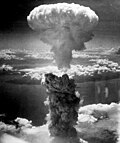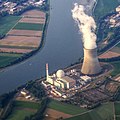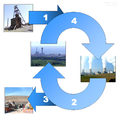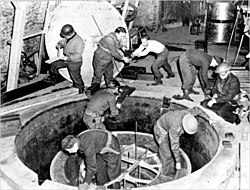Portal:Nuclear technology
The Nuclear Technology Portal
Introduction

- Nuclear technology is technology that involves the nuclear reactions of atomic nuclei. Among the notable nuclear technologies are nuclear reactors, nuclear medicine and nuclear weapons. It is also used, among other things, in smoke detectors and gun sights. (Full article...)
- Nuclear power is the use of nuclear reactions to produce electricity. Nuclear power can be obtained from nuclear fission, nuclear decay and nuclear fusion reactions. Presently, the vast majority of electricity from nuclear power is produced by nuclear fission of uranium and plutonium in nuclear power plants. Nuclear decay processes are used in niche applications such as radioisotope thermoelectric generators in some space probes such as Voyager 2. Reactors producing controlled fusion power have been operated since 1958 but have yet to generate net power and are not expected to be commercially available in the near future. (Full article...)
- A nuclear weapon is an explosive device that derives its destructive force from nuclear reactions, either fission (fission or atomic bomb) or a combination of fission and fusion reactions (thermonuclear weapon), producing a nuclear explosion. Both bomb types release large quantities of energy from relatively small amounts of matter. (Full article...)
General images -
Selected article -
The Alsos Mission was created after the September 1943 Allied invasion of Italy as part of the Manhattan Project's mission to coordinate foreign intelligence related to enemy nuclear activity. The team had a twofold assignment: search for personnel, records, material, and sites to evaluate the above programs and prevent their capture by the Soviet Union. Alsos personnel followed close behind the front lines in Italy, France, and Germany, occasionally crossing into enemy-held territory to secure valuable resources before they could be destroyed or scientists escape or fall into rival hands.
The Alsos Mission was commanded by Colonel Boris Pash, a former Manhattan Project security officer, with Samuel Goudsmit as chief scientific advisor. It was jointly staffed by the Office of Naval Intelligence (ONI), the Office of Scientific Research and Development (OSRD), the Manhattan Project, and Army Intelligence (G-2), with field assistance from combat engineers assigned to specific task forces.
Alsos teams were successful in locating and removing a substantial portion of the German research effort's surviving records and equipment. They also took most of the senior German research personnel into custody, including Otto Hahn, Max von Laue, Werner Heisenberg and Carl Friedrich von Weizsäcker. By November-December 1944, they had concluded that there was no threat of a German atomic bomb, and that the German nuclear program had only reached an experimental phase, not a production phase. After the defeat of Japan, an Alsos mission was sent in to evaluate its nuclear program as well. (Full article...)
Selected picture -

Did you know?
- ... that campaigning by climate activist Kimiko Hirata halted plans to build 17 new coal-fired power plants following the Fukushima nuclear disaster in Japan?
- ... that the British Tychon missile was developed from a Barnes Wallis concept to keep strike aircraft safe while dropping nuclear bombs?
- ... that an official investigation found the Fukushima nuclear accident was foreseeable and preventable?
- ... that Trump wrote a letter to Ali Khamenei in an effort to initiate new nuclear negotiations with Iran?
- ... that an Iowa TV station was paid for by surplus Manhattan Project funds?
- ... that poet Peggy Pond Church became a strong pacifist and a member of the Society of Friends after the Manhattan Project used her home as a place to build nuclear weapons?
Related WikiProjects
Things you can do
| Parts of this portal (those related to section) need to be updated. Please help update this portal to reflect recent events or newly available information. Relevant discussion may be found on the talk page. (September 2021) |
|
Here are some Open Tasks :
|
Selected biography -
Born and raised in Adelaide, South Australia, Oliphant graduated from the University of Adelaide in 1922. He was awarded an 1851 Exhibition Scholarship in 1927 on the strength of the research he had done on mercury, and went to England, where he studied under Sir Ernest Rutherford at the University of Cambridge's Cavendish Laboratory. There, he used a particle accelerator to fire heavy hydrogen nuclei (deuterons) at various targets. He discovered the respective nuclei of helium-3 (helions) and of tritium (tritons). He also discovered that when they reacted with each other, the particles that were released had far more energy than they started with. Energy had been liberated from inside the nucleus, and he realised that this was a result of nuclear fusion.
Oliphant left the Cavendish Laboratory in 1937 to become the Poynting Professor of Physics at the University of Birmingham. He attempted to build a 60-inch (150 cm) cyclotron at the university, but its completion was postponed by the outbreak of the Second World War in Europe in 1939. He became involved with the development of radar, heading a group at the University of Birmingham that included John Randall and Harry Boot. They created a radical new design, the cavity magnetron, that made microwave radar possible. Oliphant also formed part of the MAUD Committee, which reported in July 1941, that an atomic bomb was not only feasible, but might be produced as early as 1943. Oliphant was instrumental in spreading the word of this finding in the United States, thereby starting what became the Manhattan Project. Later in the war, he worked on it with his friend Ernest Lawrence at the Radiation Laboratory in Berkeley, California, developing electromagnetic isotope separation, which provided the fissile component of the Little Boy atomic bomb used in the atomic bombing of Hiroshima in August 1945.
After the war, Oliphant returned to Australia as the first director of the Research School of Physical Sciences and Engineering at the new Australian National University (ANU), where he initiated the design and construction of the world's largest (500 megajoule) homopolar generator. He retired in 1967, but was appointed Governor of South Australia on the advice of Premier Don Dunstan. He became the first South Australian-born governor of South Australia. He assisted in the founding of the Australian Democrats political party, and he was the chairman of the meeting in Melbourne in 1977, at which the party was launched. Late in life he witnessed his wife, Rosa, suffer before her death in 1987, and he became an advocate for voluntary euthanasia. He died in Canberra in 2000. (Full article...)
Nuclear technology news
- 13 June 2025 – Middle Eastern crisis
- The Israeli Air Force launches a bombing campaign against Iran targeting nuclear facilities with the main goal of the operation being to destroy Iran's nuclear program. A special state of emergency is declared in Israel by Defence Minister Israel Katz and Israeli airspace is closed to all flights. (BBC News)
- Israel also launches targeted assassination strikes against senior Iranian government officials, Iranian military leadership and senior nuclear scientists. (Reuters)
- The Israeli military confirms it has targeted nuclear facilities in Iran with the main goal of the operation being to destroy Iran's nuclear program. Israeli prime minister Benjamin Netanyahu confirms Israeli warplanes have targeted Iran's main Natanz Nuclear Facility. It is later confirmed that the underground nuclear reactor at Natanz has been destroyed by a bunker buster. (The Jerusalem Post) (BBC News)
- Those killed in the Israeli decapitation strikes include commander-in-chief of the Islamic Revolutionary Guard Corps Hossein Salami, senior nuclear scientist and former head of the Atomic Energy Organization of Iran Fereydoon Abbasi, and chief of the General Staff of the Armed Forces of the Islamic Republic of Iran Mohammad Bagheri and Quds Force commander Esmail Qaani. (The Times of Israel) (BBC News)
Related portals
Related topics
Subcategories
Associated Wikimedia
The following Wikimedia Foundation sister projects provide more on this subject:
-
Commons
Free media repository -
Wikibooks
Free textbooks and manuals -
Wikidata
Free knowledge base -
Wikinews
Free-content news -
Wikiquote
Collection of quotations -
Wikisource
Free-content library -
Wikiversity
Free learning tools -
Wiktionary
Dictionary and thesaurus




































































































